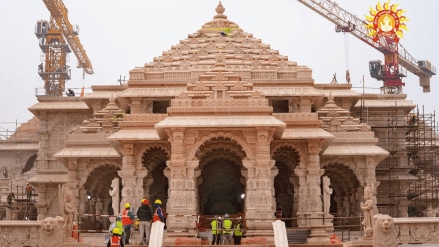From FMCG firms to retail and hospitality companies, India Inc. has its eyes on the one market that has been making headlines for the past several months – Ayodhya. With the high profile Ram Mandir inauguration slated for next week, brands such as Dabur, ITC and Adani Wilmar have rolled out high-decibel marketing initiatives in Uttar Pradesh’s holy city. As per government sources, Ayodhya’s tourist footfalls are expected to triple by 2030 to reach 6.8 crore from 2.03 in 2023, thus explaining corporate India’s interest in the region.
Take Mangaldeep, ITC’s Agarbatti brand for instance, which has created a corridor with five-foot tall agarbattis within the temple premises. It has also donated its flagship dhoop, the “Mangaldeep 3 in 1” for six months from the temple’s opening date. FMCG firm Adani Wilmar has tied up with 10 snack stores in the market to sell its ‘pakoda platter’ created especially for the Ram Mandir inauguration. It will also organise a one-day ‘bhog’ event prepared with the brand’s products for 5,000 people.
Dabur has also tied up with dhabas and eateries on the Lucknow, Gorakhpur and Varanasi highways leading to Ayodhya, showcasing its Hajmola and Real brands. Customers will be served free Hajmola digestive sachets instead of the usual fennel seeds (saunf) after meals at these dhabas. Mohit Malhotra, Dabur India CEO says, “Besides ramping up distribution of our products in the city anticipating the demand surge for daily essentials, we are also creating special experience zones in the city where pilgrims can experience our products like Real juices, Dabur Amla hair oil and Dabur Vedic Tea.”
Anshul Gupta, founder & CEO of Kirana Club (platform of 15 lakh kirana store owners) observes that from soap manufacturers to pooja samagri providers, all FMCG companies in Ayodhya are spending more on the general trade and kirana channel through in-store activations and other marketing initiatives. “Over 15% of kirana owners are also anticipating an increase in sales of packed mithai and chocolates from January 22 onwards. They are stocking up on cold drinks, personal care products, drinking water and snacks like chips along with pooja samagri like ghee, oil and diyas,” says Gupta.
Prospects for growth
There are largely two broad ways in which brands are leveraging the Ayodhya opportunity. The first is moment marketing, usually digital-led, much like brands do around Diwali and other festive occasions. The other, largely deployed by FMCG firms, involves more on-ground activations and other hyper-local initiatives, says Sahil Shah, president. digital experience, Dentsu Creative India. However, despite the hype around Ayodhya’s highly anticipated event, he adds that the spending will not run into very large numbers. “Brands won’t be spending more than 1-2% of their marketing budgets. This is because most of them will leverage social media for organic traction, while some will focus on event-based activations with budgets going up to Rs 30-50 lakh at the most,” explains Shah. Outdoor advertising is also critical, with companies like Wipro Consumer Care placing its branding strategically along the route to the Ram Mandir and other key touch points in the region. “FMCG brands are leveraging both traditional and digital media, ensuring strategic placements to maximise visibility. The aim is to resonate positively with the local community and visitors,” says Amarjeet Singh Hudda, COO, Laqshya Media.
Experts believe the ad spending during the Ram Mandir ceremony is not very different from the popular Kumbh Mela, which attracts over 100 brands. These are still early days for a market like Ayodhya and there is still a lot of promise for Indian businesses. Karan Taurani, senior vice-president at Elara Capital, expects that Ayodhya will see greater spending and brand interest in the coming years. “Now that Ayodhya also has an airport, we will see more mobility and tourism in the region. Larger food chains like Pizza Hut and Burger King will expand their presence in the market, while they might restrict their offerings to vegetarian fare. We’ve seen a similar growth trend in other popular pilgrimage destinations such as Varanasi and Amritsar,” adds Taurani.
IndiGo, Air India Express and Akasa have all introduced flights to Ayodhya from major Indian cities, boosting connectivity. The city has seen a facelift ahead of the temple ceremony, complete with a new railway station.
It’s not just FMCG brands that have taken note of Ayodhya’s growth prospects. Hotel brands and retail chains are also actively eyeing the market, says Anuj Kejriwal, CEO and MD of Anarock Retail. The company has been instrumental in launching brands like Pantaloons, Dishoom Cinemas, Reliance Smart Bazaar and Skechers in Ayodhya. He explains that real estate demand increased significantly in the region since 2019 after the Supreme Court verdict. “There has been a significant jump in prices between 2019 and 2023. For areas within city limits, average prices have increased to Rs 4,000 and Rs 6,000 per sq ft,” points out Kejriwal, adding that the city will soon become a hotbed for hospitality firms across all budget bandwidths. Chains such as Taj, Marriott, Oberoi, Trident, Wyndham, Radisson and Ginger already have projects in the city underway.
a media-based SaaS platform along with several other initiatives on the technology front.
